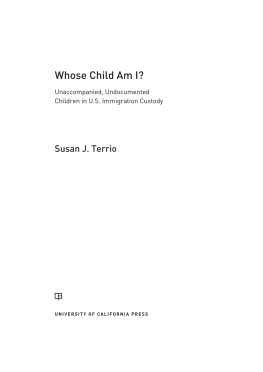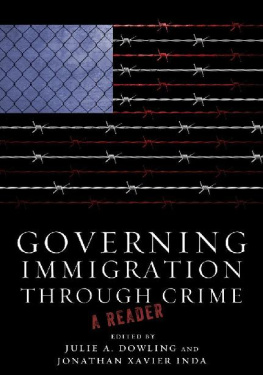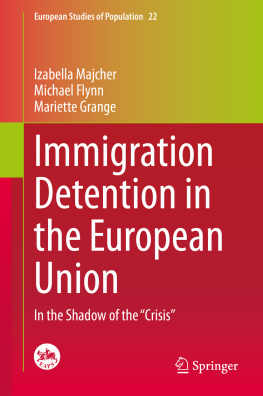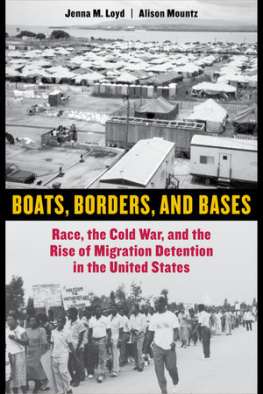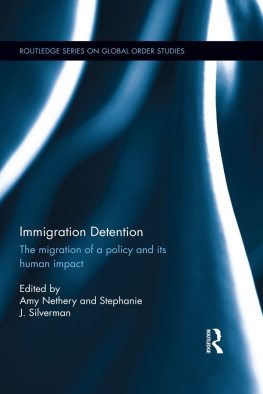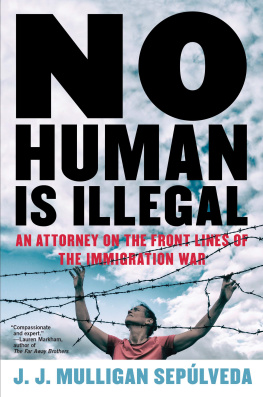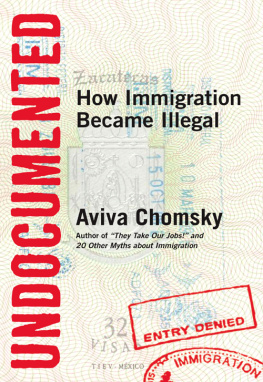
Illegal Encounters
Illegal Encounters
The Effect of Detention and Deportation on Young People
Edited by Deborah A. Boehm and Susan J. Terrio

NEW YORK UNIVERSITY PRESS
New York
NEW YORK UNIVERSITY PRESS
New York
www.nyupress.org
2019 by New York University
All rights reserved
Chapter 1 was previously published in The Land of Open Graves: Living and Dying on the Migrant Trail, by Jason De Len. University of California Press, 2015. Reprinted with permission.
References to Internet websites (URLs) were accurate at the time of writing. Neither the author nor New York University Press is responsible for URLs that may have expired or changed since the manuscript was prepared.
Library of Congress Cataloging-in-Publication Data
Names: Boehm, Deborah A., editor. | Terrio, Susan J. (Susan Jane), 1950 editor.
Title: Illegal encounters : the effect of detention and deportation on young people / edited by Deborah A. Boehm and Susan Terrio.
Description: New York : New York University Press, 2018. | Includes bibliographical references and index.
Identifiers: LCCN 2018012214| ISBN 9781479887798 (cl : alk. paper) | ISBN 9781479861071 (pb : alk. paper)
Subjects: LCSH: Illegal alien childrenGovernment policyUnited States. | Illegal alien childrenUnited StatesSocial conditions. | Juvenile detentionUnited States. | DeportationUnited States. | MexicansLegal status, laws, etc.United States. | Central AmericansLegal status, laws, etc.United States.
Classification: LCC JV6600 .I55 2018 | DDC 364.1/370830973dc23
LC record available at https://lccn.loc.gov/2018012214
New York University Press books are printed on acid-free paper, and their binding materials are chosen for strength and durability. We strive to use environmentally responsible suppliers and materials to the greatest extent possible in publishing our books.
Manufactured in the United States of America
10 9 8 7 6 5 4 3 2 1
Also available as an ebook
Contents
Deborah A. Boehm and Susan J. Terrio
Jason De Len
Tobin Hansen
Joanna Dreby
Jos Ortiz-Rosales and Kristen Jackson
Williams Guevara Martnez
Susan Bibler Coutin
Nina Rabin and Cecilia Menjvar
Susan J. Terrio
Wendy Young and Megan McKenna
Dana Leigh Marks
Lauren Heidbrink
Carolina Valdivia
Deborah A. Boehm
Abel Nez and Rachel Gittinger
Margarita Salas-Crespo
Jacqueline Bhabha
Encounters with Illegality
Deborah A. Boehm and Susan J. Terrio
Fleeing violence in their home nation of Honduras, young Diego and his mother, Wendy Osorio Martinez, came to the United States seeking asylum. They were apprehended by US Border Patrol agents and transferred to Berks County Residential Center in Pennsylvania, one of three US immigration detention centers that hold women and children. They were ordered released after being held for nearly two years654 daysin the facility, during which time Diego, three years old when he left detention, had learned to walk and talk.
***
In February 2017, twenty-one-year-old Juan Manuel Montes Bojorquez was deported from the United States, despite his status as a recipient of Deferred Action for Childhood Arrivals (DACA), and although he migrated with his family as a nine-year-old and had spent most of childhood in the country. A brief interaction with law enforcementa US Border Patrol officer asked Juan for identification as he was walking in Calexico, Californiaresulted in his deportation later that night. Today he lives in Mexico, far from family and friends.
***
When Guadalupe Garca de Rayos went for her annual check-in with US immigration officials, US Immigration and Customs Enforcement (ICE) agents took her into custody while her husband and two US citizen children waited outside. ICE later announced that Guadalupe would be deported. Although her children and a group of immigrant advocates tried to block the van transporting her, ICE deported Guadalupe
***
In each of these cases, young people faced distinct circumstances, had diverse experiences, and held different immigration statuses, and yet collectively these encounters demonstrate similar patterns in the ways that children and youth interact with government agents and institutions. This books main intent is to track and understand how young people encounter, move through, and/or are outside of a range of legal processes, including border enforcement, immigration detention, federal custody, courts, and state processes of categorization. Even if young people do not directly enter state immigration systemsbecause they are US citizens or have avoided detention as undocumented immigrantsthey are nonetheless deeply impacted by the invasive reach of government in its many forms.
Thus, this books title, Illegal Encounters, highlights our focus on young peoples interactions or encounters problematizes illegality itself, showing how categories assumed to be natural are in fact created by laws, lawmakers, and government bodies and agencies that carry out immigration enforcement.
Throughout this volume, we consider childrens and young peoples many encounters with illegality, deportability,consequences. In what ways do political, legal, social, educational, and other systems shape childrens experiences of immigration, and how do young immigrants and immigrant families negotiate the increasingly restrictive state actions of immigration control and policing?
In the United States, millions of children and youth are undocumented migrants or have family members who came to this country without authorization. In this context, the unique challenges faced by young peoplefrom new arrivals to long-term residents with a range of immigration statuses and citizenshipsdemand special attention. The media stories, reports by nongovernmental organizations (NGOs), and occasional documentary films on this subject provide only a partial view of this complicated set of circumstances. This volume takes a comprehensive and systemic approach by following children and youth as they cross the border, suffer apprehension and detention by immigration authorities, go through removal proceedings in immigration courts, lead lives in the shadows outside of legal systems, and witness the migration experiences of their loved ones. We turn our attention to how these processes unfold within specific local, national, and transnational contextsin the United States and across the Americas, especially Mexico and Central American countriesas people migrate across the US-Mexico border and as the US government enacts policies and laws aimed at controlling and restricting such movement.
In the following pieces, then, contributors focus on the challenges that young migrants from the Americas face within and/or outside of the purview of overlapping criminal, immigration, and child welfare systems, whether in the United States or in their countries of origin. Children and youth who migrate to this country find themselves curiously situated both within and outside of different systems, and often betwixt and between different frameworks, institutional responses, and laws. For example, children may be treated as adults in immigration courts; criminalized and held in secure facilities even if very young; caught up in immigration enforcement aimed at their parents; granted temporary legal status (or not) as young people raised in the United States; and/or subject to government policies and practices but without the constitutional rights granted to citizens. The paradoxical and perplexing positionality of children vis--vis immigration and other state regimes is the result of a combination of factors and aspects of identity, including age, citizenship, family relations, race, gender, and class position, among others. We maintain that children, youth, and young adults uniquely grapple with these contradictions, because of their categorization as minors or as members of the next generation, and because of the particular ways in which they are perceived socially, culturally, and within institutions. We therefore focus on precisely this positioning of young people in, between, and outside of legal systems and institutions.
Next page

